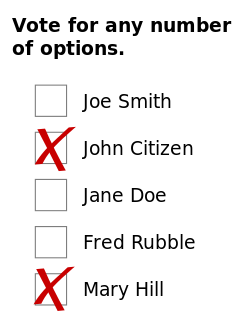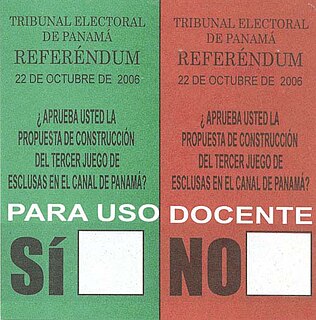
Approval voting is an electoral system where each voter may select ("approve") any number of candidates, and the winner is the candidate approved by the largest number of voters. It is distinct from plurality voting, in which a voter may choose only one option among several, whereby the option with the most votes is chosen. It is related to score voting in which voters give each option a score on a scale, and the option with the highest total of scores is selected. Approval voting can also be used in multiwinner elections; see multiwinner approval voting.
Plurality voting is an electoral system in which each voter is allowed to vote for only one candidate, and the candidate who polls more than any other counterpart is elected. In a system based on single-member districts, it may be called first-past-the-post (FPTP), single-choice voting, simple plurality or relative/simple majority. In a system based on multi-member districts, it may be referred to as winner-takes-all or bloc voting.
In voting methods, tactical voting occurs in elections with more than two candidates, when a voter supports another candidate more strongly than their sincere preference in order to prevent an undesirable outcome.
A referendum is a direct vote by the electorate on a particular proposal or issue. This is in contrast to an issue being voted on by a representative. It can have nationwide or local forms. This may result in the adoption of a new policy or specific law. In some countries, it is synonymous with or commonly known by other names including a plebiscite, votation,ballot question, ballot measure, or proposition.

Voting is a method for a group, such as a meeting or an electorate, in order to make a collective decision or express an opinion usually following discussions, debates or election campaigns. Democracies elect holders of high office by voting. Residents of a place represented by an elected official are called "constituents", and those constituents who cast a ballot for their chosen candidate are called "voters". There are different systems for collecting votes, but while many of the systems used in decision-making can also be used as electoral systems, any which cater for proportional representation can only be used in elections.

Steven J. Brams is an American game theorist and political scientist at the New York University Department of Politics. Brams is best known for using the techniques of game theory, public choice theory, and social choice theory to analyze voting systems and fair division. He is one of the independent discoverers of approval voting, as well as extensions of approval voting to multiple-winner elections to give proportional representation of different interests.
Disapproval voting is any electoral system that allows many voters to express formal disapproval simultaneously, in a system where they all share some power. Unlike most electoral systems, it requires that only negative measures or choices be presented to the voter or representative. If used to select candidates for an office, or for continuation to a next round of voting or play, it is either single- or multi-winner, as everyone who is not disapproved of is in effect a winner, for that round.
The participation criterion is a voting system criterion. Voting systems that fail the participation criterion are said to exhibit the no show paradox and allow a particularly unusual strategy of tactical voting: abstaining from an election can help a voter's preferred choice win. The criterion has been defined as follows:
Noocracy, or "aristocracy of the wise", as originally defined by Plato, is a system of governance where decision making is in the hands of philosophers, similar to his idea of philosopher kings. The idea was further expanded upon by geologist Vladimir Vernadsky, and philosophers Pierre Teilhard de Chardin and Édouard Le Roy, and their concept of the noosphere.
In single-winner voting system theory, the Condorcet loser criterion (CLC) is a measure for differentiating voting systems. It implies the majority loser criterion.
Anti-plurality voting describes an electoral system in which each voter votes against a single candidate, and the candidate with the fewest votes against wins. Anti-plurality voting is an example of a positional voting method.
CPO-STV, or the Comparison of Pairs of Outcomes by the Single Transferable Vote, is a ranked voting system designed to achieve proportional representation. It is a more sophisticated variant of the Single Transferable Vote (STV) system, designed to overcome some of that system's perceived shortcomings. It does this by incorporating some of the features of Condorcet's method, a voting system designed for single-winner elections, into STV. As in other forms of STV, in a CPO-STV election more than one candidate is elected and voters must rank candidates in order of preference. As of February 2021, it has not been used for a public election.

An electoral system or voting system is a set of rules that determine how elections and referendums are conducted and how their results are determined. Political electoral systems are organized by governments, while non-political elections may take place in business, non-profit organisations and informal organisations. These rules govern all aspects of the voting process: when elections occur, who is allowed to vote, who can stand as a candidate, how ballots are marked and cast, how the ballots are counted, how votes translate into the election outcome, limits on campaign spending, and other factors that can affect the result. Political electoral systems are defined by constitutions and electoral laws, are typically conducted by election commissions, and can use multiple types of elections for different offices.
Satisfaction approval voting (SAV) is an electoral system that extends the concept of approval voting to a multiple winner election. It was proposed by Steven Brams and Marc Kilgour in 2010.
Proportional approval voting (PAV) is an electoral system which is an extension of approval voting to multiple-winner elections. It applies proportional representation principles with a ballot which is no more complicated than ballots for plurality voting. It allows each voter to vote for as many or as few candidates as they choose. The system was invented by Thorvald N. Thiele. It was rediscovered by Forest Simmons in 2001, who coined the name "proportional approval voting".
Sequential proportional approval voting (SPAV) or reweighted approval voting (RAV) is an electoral system that extends the concept of approval voting to a multiple winner election. It is a simplified version of proportional approval voting. Proposed by Danish statistician Thorvald N. Thiele in the early 1900s, it was used in Sweden for a short period after 1909.
Wollheim's paradox is a problem in political philosophy that points to an inherent contradiction in the concept of democracy. The paradox highlights the fact that a person can simultaneously advocate two conflicting policy options A and B, provided that the person believes that democratic decisions should be followed. The paradox was formulated by the British philosopher Richard Wollheim in 1962 in an article entitled "A paradox in the theory of democracy".
Electoral systems are the rules for conducting elections; a voting method is an algorithm for determining the winner from the ballots cast. This article discusses the justifications which have been offered for different voting methods, both those which elect a unique candidate from a ‘single-winner’ election and those which elect a group of representatives from a multiwinner election. The choice between the two types of election is a political question not discussed here.
In the study of voter behavior, the efficient voter rule speaks to the desirability of voter-driven outcomes. It applies to situations involving negative externalities such as pollution and crime, and positive externalities such as education. Related efforts to achieve socially optimal quantities of externalities have long been a focus of microeconomic research, most famously by Ronald Coase and Arthur Pigou. Externality problems persist despite past remedies, which makes newer approaches such as the efficient voter rule important.
The mathematical theory of democracy is an interdisciplinary branch of the public choice and social choice theories. It operationalizes the fundamental idea to modern democracies — that of political representation, in particular focusing on policy representation - how well the electorate's policy preferences are represented by the party system and the government. The representative capability is measured by means of dedicated indices that are used both for analytical purposes and practical applications.